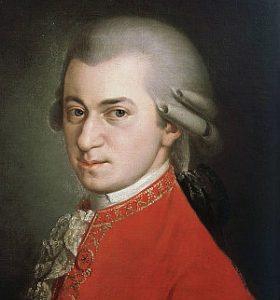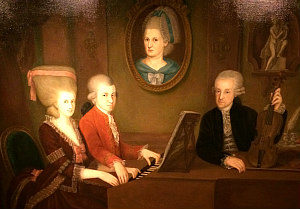To boost your knowledge of Mozart operas this one pager will put you on the fast track. Likewise, it’s the perfect decision tool if you are planning to buy Mozart opera music, prepare for a music tour in Vienna or need to decide between various operas on stage.
What Makes Mozart Operas Special?
 In total, Mozart (1756 to 1791) wrote 22 operas in just 35 years of his life. What makes them so special is that they hold incredibly expressive tunes: Depending on the genre and the specific opera they connect you with love, hate, joy, pain and indifference like no other musical dramas.
In total, Mozart (1756 to 1791) wrote 22 operas in just 35 years of his life. What makes them so special is that they hold incredibly expressive tunes: Depending on the genre and the specific opera they connect you with love, hate, joy, pain and indifference like no other musical dramas.
In general, operas by Wolfgang Amadeus Mozart belong to either the opera seria, the opera buffa (comic opera) or the German singspiel. If you believe opera experts, Mozart’s later works are also his most mesmerizing. However, in the past years opera gurus and fans have increasingly appreciated many of his early works, such as Bastien und Bastienne.
As regards relevance, you will find that most topics and characters of Mozart operas are timeless: For example, take the stories of Don Giovanni and Cosí Fan Tutte. In fact, their characters display shocking parallels with many of today’s celebrities!
To help you evaluate Mozart operas more easily the following guide to his top 10 operas splits into the three opera categories.
Opera Seria
As a matter of fact, the opera seria is the classic 17th and 18th century opera, often based on mythological Greek and Roman tragedies and heroic stories.
Usually, Emperors, kings and other aristocratic personalities would commission an opera seria to legitimise their powers.
1. Idomeneo
Premiere: 1781, Munich
Libretto: Giambattista Varesco (adaptation of Antoine Danchet’s Idomene)
Duration: approx. 3.5 hours (including two breaks)
Acts: 3
Plot: Just after the Troyan War, Mozart’s Greek tragedy rolls up the story of King Idomeneo and the power of the Gods. After successful battles in Troy Idomeneo returns to Crete. His son Idamante, Mykenic princess Elettra, Troyan princess and prisoner of war Ilia, and the people of Crete await him. Consequently, a drama of love unfolds between the two princesses and the Cretian prince. Most dramatically, Idamante’s conscience needs to decide between Elettra, who symbolises his people, and Ilia, who belongs to the enemy but whom he had rescued from a sea storm earlier.
Besides the love drama, another drama unfolds between father and son. Having been rescued from a storm by Poseidon (Greek god of the seas), Idomeneo had promised to sacrifce the first human being he would encounter when going on shore. As fate will have it, that human being turns out to be his son Idamante. On top, Idomeneo learns that his son is in love with the enemy (Ilia). Hence he decides to send Idamante together with Elettra to Mykene.
But the people of Crete have had enough of the storms, caused, as they believe, by a sea monster. They demand the sacrifice of Idamante. The prince however, kills the sea monster, but still, Poseidon wants to see him dead. At the last moment, Poseidon himself intervenes: Idomeneo shall renounce the throne in favour of Idamante and Ilia.
2. La Clemenza Di Tito
Premiere: 1791, Prague
Libretto: Caterino Mazzola (adaptation of Pietro Metastasio’s text book)
Duration: approx. 2.25 hours
Acts: 2
Plot: Written shortly before Mozart’s death, this last Mozart opera dramatises the unusual personality of Roman Emperor Titus, a bloodthirsty warlord turned clement Emperor.
Having devastated Jerusalem and Palestine and killed a million people, Titus crowns himself Emperor of Rome following Emperor Vitellius’ death. His daughter Vitellia wants to marry Titus, who in turn is in love with Berenice. What follows is a series of intrigues against Titus. For the love of his people, Titus renounces his love of Berenice, and is ready to marry Servilia.
But Servilia loves Annius. Fortunately, the Emperor understands matters of the heart and even offers to marry Servilia and Annius. In the meantime, Vitellia sends out her lover Sextus to kill Titus. After a failed attempt of murder against him and watching his Capitol burning down, Titus forgives both Sextus and Vitellia.
This Mozart opera was commissioned for the coronation of Austrian Emperor Leopold II to King of Bohemia. Surprisingly, the drama is far less feudal than it seems. In the best case, a sovereign who didn’t execute his full powers was regarded as weak. Unusual for an opera seria, Mozart included eight ensembles. In three of those, the Emperor Titus himself sings alongside his people.
Mozart Operas And Concerts Across Europe
 If you love Mozart and travel to Europe make sure you experience at least one Mozart concert and one opera on his home continent. Find out in this up-to-date opera calendar for Vienna (and embedded sites for Barcelona, Rome, Prague and Venice) whether Mozart will be on the menu during your stay.
If you love Mozart and travel to Europe make sure you experience at least one Mozart concert and one opera on his home continent. Find out in this up-to-date opera calendar for Vienna (and embedded sites for Barcelona, Rome, Prague and Venice) whether Mozart will be on the menu during your stay.
For concerts, click for an up-to-date Mozart concert calendar from Amsterdam, Barcelona, Berlin and Krakow to London, Paris and Vienna.
3. Ascanio In Alba
Premiere: 1771, Milan
Libretto: Giuseppe Parini
Duration: approx. 3.5 hours
Acts: 2
Plot: This Mozart opera takes place in the mythical ancient world, in the pastoral landscape of Alba. Venus, the Roman goddess of love, rules Alba and its people with benevolence. She encourages her son to take over and become King of Alba. Following the death of Aeneas, Ascanio’s father, Venus is aware that she will not be able to preside over Alba forever but follow Aeneas to the world of the Gods. However, Ascanio is more concerned about marrying Silvia. With Cupido’s help, Venus tests the virtues of her daughter-in-law to be. The happy end: Ascanio and Silvia make their way to the altar.
Like many serious Mozart operas, Wolfgang Mozart composed this oeuvre on commission. Empress Maria Theresia wanted to use the opera for the wedding celebrations of her third son Archduke Ferdinand, and Maria Beatrice d’Este of Modena. Hence, Venus symbolises Maria Theresia, Ascanio refers to Archduke Ferdinand, and Silvia to Maria Beatrice.
Opera Buffa (Comic Opera)
Mozart Operas. The opera buffa is a comic Italian opera, in contrast to the opera seria. It was created after the opera seria from around 1750, and was very popular in the Vienna classic era.
The ‘opera buffa’ operas by Wolfgang Amadeus Mozart (Le nozze di Figaro / Don Giovanni / Così fan tutte / Die Zauberflöte) have created the most catchy and joyful opera tunes.
4. Don Giovanni
Premiere: 1787, Prague
Libretto: Lorenzo da Ponte
Duration: approx. four hours (including one break)
Acts: 2
Famous Arias: Champagne aria, Register aria;
Plot: Don Giovanni (Don Juan) is an unscrupulous womanizer in this opera buffa, which takes place in 17th century Seville. The harder his victims are to get, the more enjoyable for him. One day, Don Giovanni kills the father of one of his victims, Donna Anna, who tried to save his daughter from Don Giovanni’s unwanted advances. Subsequently, he erroneously tries to win a former lover (Donna Elvira) and to burst into the wedding of Zerlina and Masetto. In the meantime, Donna Anna, her fiance Don Ottavio, and Donna Elvira conspire to convict Don Giovanni as a murderer.
During the conquest of Donna Elvira’s maid, Don Giovanni and his servant Leporella change roles, starting a comedy of errors. After that, a rather bizarre ghostly encounter takes place: Don Giovanni hears the murdered father of Donna Anna speak from his grave. He invites him for dinner (!) Finally, his guest arrives and in turn asks him to join him. Feeling no regrets for all his unscrupulous behaviour, Don Giovanni accepts. What he doesn’t know: It is the gates of hell that open to devour him forever.
5. The Marriage of Figaro
Premiere: 1786, Vienna
Libretto: Lorenzo da Ponte
Duration: approx. 3.25 hours (including one break)
Acts: 4
Plot: To begin with, Spanish Count Almaviva marries Rosina and settles in his country estate. However, his marriage doesn’t prevent him from intentions to make use of the feudal right of the first night with Susanna, the bride of his servant Figaro. Consequently, the cunning servant decides to fight Count Almaviva’s plan. Figaro himself is followed by Marcellina, an old spinster who claims an old promise of Figaro to marry her in return for lending her money. And Countess Rosina is secretly admired by Cherubino, a footboy of Count Almaviva.
Encouraged by Figaro and Susanna, Rosina decides to win back her husband through a cunning play with Cherubino. It turns out that Figaro himself is the son of Marcellina and Rosina’s foster father Dr. Bartolo. A comedy of errors starts to get Count and Countess, and Susanna and Figaro, together, with the help of Cherubino and Barbarina, the gardener’s daughter. As usual for comic Mozart operas, the Marriage of Figaro ends with (three) happy couples.
![]() My tip: At the Mozart House in Vienna, the Figaro Parallelo media installation shows ten scenes from the opera, permitting a comparison of seven recent production of The Marriage of Figaro. In the centre you will see the historical Figaro as a mirror projection in a special theatre model.
My tip: At the Mozart House in Vienna, the Figaro Parallelo media installation shows ten scenes from the opera, permitting a comparison of seven recent production of The Marriage of Figaro. In the centre you will see the historical Figaro as a mirror projection in a special theatre model.
The Marriage of Figaro contains some of the most popular pieces of Mozart music, namely the overtures and arias. Listen in to the overture in the video below.
6. Cosí fan Tutte
Premiere: 1790, Vienna
Libretto: Lorenzo da Ponte
Duration: approx. 3.25 hours (including one break)
Acts: 2
Famous Arias: Fiordiligi’s aria, Guglielmo’s aria;
Plot: Guglielmo and Ferrando, two Italian men, make a bet with Don Alfonso. The noble man believes that no woman is forever faithful. Guglielmo and Ferrando want to prove that their brides to be Fiordiligi and Dorabella are. They disguise as Albanians, while Don Alfonso tells the two sisters that their bridegrooms need to join the military. The false Albanians approach Fiordiligi and Dorabella, and soon make a pass at them. At first, both are confirm their love to their bridegrooms. However, after the Albanians threaten to commit suicide if the girls reject them, they soften up (though not enough to even exchange a kiss). Don Alfonso triumphs (cosi fan tutte – every woman does it) and cashes in the bet, while Guglielmo and Fernando re-appear in their original costumes to confront their brides and explain the joke. Both ask for forgiveness.
7. La Finta Giardiniera
Premiere: 1775, Munich
Libretto: Giuseppe Petrosellini
Duration: approx. 3.5 hours (including one break)
Acts: 3
Plot: One of the rarely played Mozart operas, La Finta Giardiniera (The Pretended Gardener) is a nice mixture of an opera buffa with elements of the opera seria. It takes place in Northern Italy. Count Belfiore almost killed his wife, Marchesa Violante, out of jealousy, and escaped because he thought she was dead. He ends up taking the noble Arminda as his fiance. Arminda is the niece of Don Anchise, the chief magistrate of the local municipality. Marchesa Violante and her servant Roberto get jobs as gardeners with Don Anchise.
However, Violante still loves Belfiore and wants to be close to him. Hence she takes the name of Sandrina, he changes his name to Nardo. Don Anchise falls in love with Violante/Sandrina. In turn, Roberto/Nardo and Don Anchise’s maid Serpetta discover their love for each other. Count Belfiore recognises Violante/Sandrina, but she denies. Don Anchise learns that Count Belfiore is the supposed murderer of the missing Violante and wants to capture Belfiore. This spurs Violante to unveil her true identity, and she forgives her husband Count Belfiore. Subsequently, his fiance Arminda returns to her old love Don Ramiro, who she had abandoned for Count Belfiore. And Don Anchise, who was in love with Violante/Sandrina, decides to wait for the next pretty servant, who would hopefully be as loyal to a husband as Violante/Sandrina. Roberto/Nardo and maid Serpetta find each other as well.
Singspiel
Mozart Operas. The German Singspiel is a form of musical theatre that consists of an overture and several arias, which are connected through dialogues without music.
8. The Magic Flute Opera
Premiere: 1791, Vienna
Libretto: Emanuel Schikaneder / Liebeskind (original story: ‘Lulu’)
Duration: approx. three hours (including one break)
Acts: 2
Famous Arias: aria of the Queen of the Night, Der Vogelfaenger bin ich ja;
Plot: Arguably the most popular Mozart opera, the Magic Flute has enchanted both adults and children alike. Its plot is a little easier than most other Mozart operas.
The Egyptian gods Isis and Osiris think that the Queen of the Night has a bad influence on her daughter Pamina. Hence they charge the priest Sarastro with Pamina’s abduction. The Queen of the Night is furious and in turn, charges Prince Tamino to free Pamina. Almost instantly Tamino falls in love with Pamina’s image which the Queen shows to him. Before she sends Tamino on his way, the bird catcher Papageno enters the scene when Tamino, chased by a giant snake sent by the Queen of the Night, faints. Together, Tamino and Papageno set forth to free Pamina. Papageno discovers her at Sarastro’s palace.
Both manage to escape but Sarastro and his servant Monostatos find them. Isis and Osiris inform Sarastro in a palm forest that Tamino and Pamino, who have really fallen in love with each other, are allowed to become a couple. However, Pamina must not return to her mother, the Queen of the Night. And Tamino and Papageno need to run through several tests of being silent, in order to enter the other rooms of Sarastro’s palace.
Meanwhile, the Queen of the Night encourages Pamina to stab Sarastro. While Tamino brilliantly passes his silence test, Papageno can’t keep his mouth shut and talks. This makes the beautiful Papagena, who appeared to him, disappear. Pamina thinks the silent Tamino doesn’t love her any more and tries to stab herself. But the magic flute, provided by the Queen of the Night, helps them to communicate.
Papageno is given a carillon with which to finally allure Papagena, with success. In the end, the Queen of the Night and Sarastro’s evil servant Monostatos die as they seek revenge. Sarastro unites Tamino and Pamina.
![]() My tip: If you want a different opera experience and travel to Vienna, the historic Marionette Theatre Schonbrunn regularly performs The Magic Flute in great quality, using their hand crafted rococo puppets.
My tip: If you want a different opera experience and travel to Vienna, the historic Marionette Theatre Schonbrunn regularly performs The Magic Flute in great quality, using their hand crafted rococo puppets.
9. The Abduction from the Seraglio
Premiere: 1782, Vienna
Libretto: Johann Gottlieb Stephanie The Younger
Duration: approx. 2.5 hours (including one break)
Acts: 3
Plot: Like Don Giovanni and The Marriage of Figaro, this Mozart opera takes place in Spain, though a little earlier (mid 16th century). The young Spanish Constanze, her English maid Blonde and Blonde’s fiance the servant Pedrillo, are attacked by pirates, who sell them on a slave market. The born Spanish and Muslim Bassa Selim buys them and lets them live under benign conditions in his palace at the seaside. Constanze’s fiance Belmonte learns of the abduction through a letter by Pedrillo and sails off to rescue the three. Finally, Belmonte finds Pedrillo.
The servant encourages Bassa Selim to employ Belmonte as a constructor. Selim’s servant Osmin, however, who knows Belmonte’s real intentions, chases him away. Pedrillo manages to make Osmin drunk, and Constanze and Belmonte escape. After Pedrillo and Blonde fail to escape, Constanze and Belmonte are brought back to Bassa Selim, too. Selim wants to execute Constanze but is deeply touched by her love to Belmonte. He forgives all four and releases them.
10. Bastien Und Bastienne
Premiere: 1768, Vienna
Libretto: Johann Andreas Schachtner (adaptation of Les amours de Bastien et Bastienne by Guervile de Harny and Charles Simon Favart)
Duration: approx. 35 minutes
Acts: 1
Plot: To start with, Bastien and Bastienne is one of the early Mozart operas, which he composed at the age of 12, and a popular opera for children. Bastienne, a shepherdess, is in love with Bastien. As fate has it, Bastien has been seduced by the cunning Phyllis, a rich girl from the town. Therefore the shepherdess asks fortune teller colas for his advice what to do to win back Bastien. Colas recommends for her to take revenge at the same level and ignore Bastien. Just a little later, Bastien appears at Colas and confesses that he wants his Bastienne back. Actually he doesn’t love Phyllis. But Colas tells him that Bastienne already belongs to someone else.
Bastien doesn’t believe Colas who then consults his book of magic. Bastienne joins and doesn’t pay any attention to Bastien. In desperation, he wants to commit suicide, but then, both remember the good times when they were a couple and reconcile.
go to Vienna Opera House
get more inspiration What To Do In Vienna
plan your music trip to Vienna with the help of Vienna Unwrapped’s Vienna Travel Concierge
back to Vienna Unwrapped homepage
